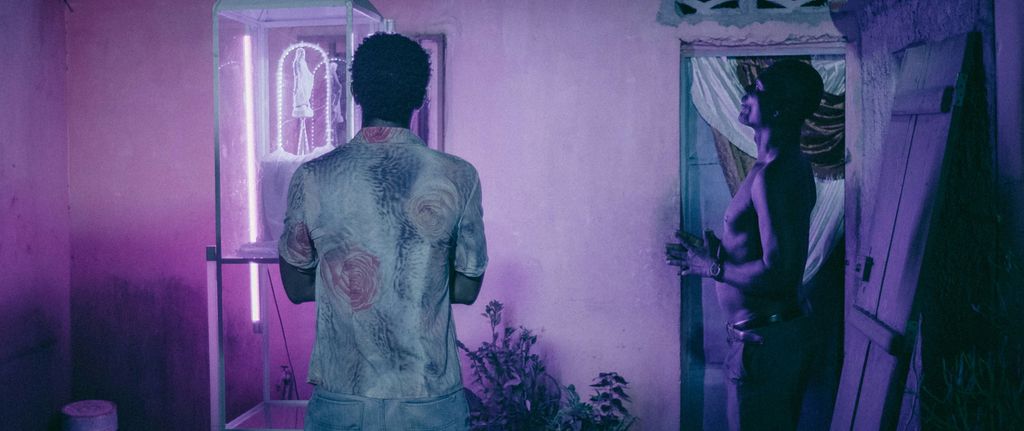Writer-director Ery Claver’s debut feature “Our Lady of the Chinese Shop” (“Nossa Senhora da Loja do Chinês”) blends poetic realism, melodrama, and video art to depict the intricate complexities of daily life in Luanda. Narrated in Mandarin by Zhang Wei (voiced by Meili Li and played by Liu Xiubing) — the owner of the titular shop in Angola’s capital — the film follows four main characters, each dealing with personal loss in a nation haunted by postcolonial trauma. The intrepid corner shop owner’s remedy for their ills — plastic Virgin Mary statuettes — promises a solution.
Aging parents Domingas (Cláudia Púcuta) and Bessa (David Caracol) are trapped in a loveless marriage, waiting for his imminent death from a Covid-like condition as their home drowns. Leaks stem from the roof – and semiotically, from their daughter’s death – producing an excess of emotion that cannot be contained.
Tightly framed shots of sensual realism capture Domingas unhurriedly carrying buckets up and down the stairs, in an endless cycle of futility as water seeps through cracks and spills over, flooding the bedroom floor.
Shadows haunt the house via chiaroscuro lighting, with mirrored images giving expression to the secrets held in its dust and the vibrant inner lives it has silenced (most evidently that of housewife Domingas, rarely seen outside its walls). Allegorical references frame the home as a national Ark, here defined by stasis rather than renewal.
The Chinese shop provides our first glimpse of Luanda as a bustling commercial hub, with the camera taking us from behind the counter out onto the street. The screen is repeatedly split by the architectural spaces of home (curtains, walls, windows, staircases) and city (highways, lanes, office blocks, storefronts), evoking what cultural theorists Ella Shohat and Robert Stam refer to as “colonial bilingualism’,” with the Portuguese and Mandarin dialogue pierced by traces of Umbundu and Kimbundu via spiritual rituals and musical traditions.
As is perhaps a universal conceit of privately run corner shops, competing to cater to the specific yet vast needs of the neighborhood, Zhang Wei’s is an assemblage of “magic remedies and household sorcery.” Yet it is also a signifier of the shift in neocolonial power dynamics attributable to the continent’s biggest trading partner. Hence his physical remove mimics the geopolitical remove of ultra-modern Chinese-owned shopping malls. This includes the neon-lit Chinatown, accessible to middle-class residents like Domingas, via newly built motorways; or to street kids like Zoyo (Willi Ribeiro), by scaling the high walls encasing it.
Aesthetically and structurally, “Our Lady of the Chinese Shop” recalls Wong Kar Wai’s “Chungking Express” (1994) in its focus on alienated individuals, who, through shot composition, Dutch angles, hand-held close-ups, and blurred backdrops, appear to move at a different speed to the teeming masses. The state of suspended animation in which they exist conveys a national crisis, as their preoccupation with the past (and tendency to repetition) threatens to overshadow their future.

The city is a character in its own right, whose labyrinthine contours Zoyo maps in the search for his missing dog Tobias.
Zhang Wei’s poetic narration enables the mise-en-scène, cinematography, and score to communicate mood and tone in ways that language cannot, while also conveying each individual’s lost articulation of thought and vision.
As with Akira Kurosawa’s work, the use of weather expressively conveys the transience of fixed concepts (while also implying imminent ecological devastation). This is enhanced by “Our Lady of the Chinese Shop’s” non-linear style, fractured narrative, and temporal blurring, here pointing to indigenous ontologies rooted in pluritemporality and multivalence.
Zhang Wei’s elevated positioning, watching the action play out from the top of the domineering edifice of the bullring, brings to mind that of Sanjuro in “Yojimbo’s” (Kurosawa, 1961) classic showdown, as he carelessly observes a city in crisis.
“Our Lady of the Chinese Shop’s” Afro-surrealist aesthetic moves our engagement with the material world beyond the shop counter to the varied and multiple spaces of the imagined and imaginable, interweaving fable and fact. Zhang Wei launches a major advertising campaign, the success of which turns his store from a miscellaneous treasure trove into a one-stop-shop for Marianist simulacra, with the reproductions lining every shelf catering to one sole need – the fundamental yearning of the human condition.

The commodification of this “white and pure” Christian icon leads to a boom in unregulated churches, where politics, corruption, and violence intermingle. It takes a Molotov cocktail hurled through the shop front’s glassy exterior to destroy the idol, the “doll of adoration, finally Black.” As stark instrumentation gives way to organ music, spiritual, commercial, and colonial empires burn.
Symbolic of failed state promises, “Our Lady of the Chinese Shop” uses Luanda’s colonial-era bullring to create a satirical moment of national potentiality, which extra-diegetically brings to mind Ghanaian artist Ibrahim Mahama’s work in transforming colonial sites into community art spaces. The stadium is populated by crowds both literally and symbolically – in alternating shots, dresses and shirts, sometimes pinned to trousers, hang from clothes lines blowing back and forth above the tiered stands.
As with the private domestic space, the public space is anthropomorphized via images and sounds (recorded snippets of crowds cheering and ululating; traditional music by Nguami Maka; Jacinto Tchipa’s “Mamãe,” a classic from the early years of independence). The supposed winds of change that blow through the crumbling amphitheater, with its sand circle and billowing cottons, carry that same dust that haunts Domingas’ home. Following “Bamako” (Sissako, Mali/US/France, 2006), the chronopolitical arena is inextricably bound up with the debris of daily life.
Having announced election results, Angolan politicians dine in the French royal tradition of the grand couvert, while the rest of the stadium looks on in silence and the youth (behind corrugated iron gates) await their chance to ravage the leftovers. A close-up of a stuffed suit is suggestive of another member at the table, the imperial power shaping the country’s fate. The funereal symbolism of the long table draped in black is juxtaposed with a farcical sensibility in the style of Luis Buñuel’s “The Discreet Charm of the Bourgeoisie” (1972).

Our narrator chuckles as he watches the tragicomedy from above just as he does when watching soap operas at home. Here the unreality of real-life – illuminated by Our Lady of the Chinese Shop’s docu-fiction form and its ability to give the immaterial materiality – reduces citizens to passive spectators. Rather than fostering communal responsibility, it produces a collective indifference to inequality.
Themes of coercion and consent link the main narratives. As politicians speak of duty and sacrifice — referring to themselves as martyrs at the altar of public service — Bessa exploits the political valence of victimhood while his wife seeks to expel the demon in her bed. Yet “Our Lady of the Chinese Shop” also features moments of joy, love, and intimacy, suggestive of alternative national futures.
Gilles Deleuze defined Kurosawa’s cinema as one of action in question. Similarly, “Our Lady of the Chinese Shop” is a film invested in searching, provoking, and interrogating. Produced by the Angolan film collective Geração 80 (Generation 80), it is a collaborative work that seeks to affirm multiplicities of perspective and truth. Endlessly open to interpretation, it is a paradigmatic example of writing through images, a film essay on power dynamics that demands intellectual attention while allowing its audience to dream.
“Our Lady of the Chinese Shop” world premiered at the Locarno Film Festival in August, and will next screen at the BFI London Film Festival in October.
Dr. Zélie Asava is a Screen Studies academic. She is the author of Mixed Race Cinemas: Multiracial Dynamics in America and France and The Black Irish Onscreen: Representing Black and Mixed-Race Identities on Irish Film and Television, and co-editor of a special issue of the Journal of Scandinavian Cinema.
